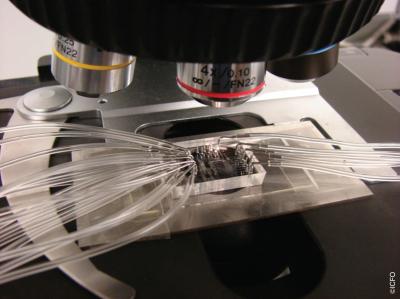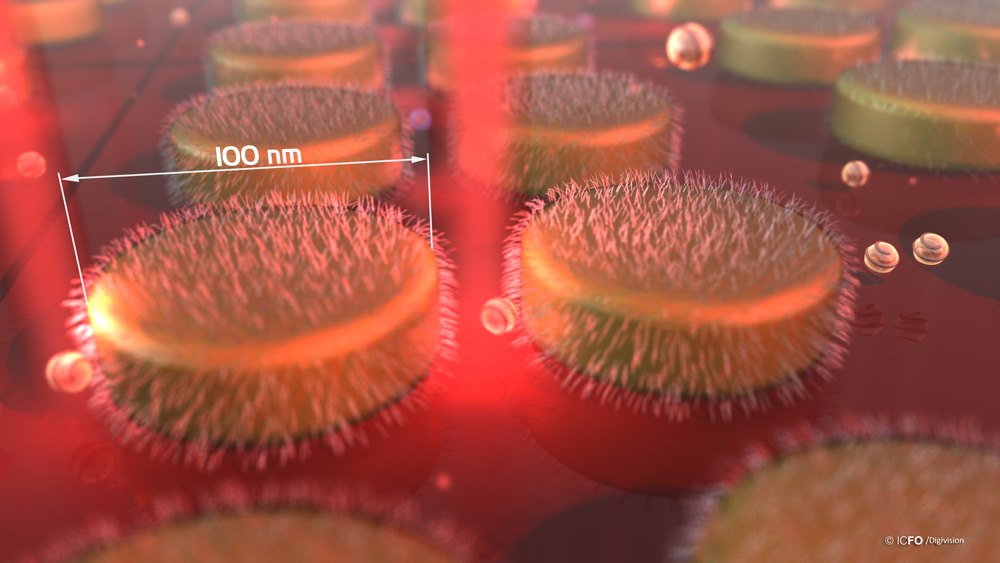An ultra-sensitive chip for early cancer detection
May 19, 2014

The ICFO lab-on-a-chip (credit: ICFO)
An international team of researchers, led by ICFO – Institute of Photonic Sciences in Castelldefels, has developed a “lab-on-a-chip” platform capable of detecting very low concentrations of protein cancer markers in the blood, using the latest advances in plasmonics, nano-fabrication, microfluids and surface chemistry.
Currently, most cancers are detected when the tumor is already composed of millions of cancer cells and the disease is starting to advance into a more mature phase.
The new device enables diagnoses of the disease in its earliest stages before it take hold, which would be key to successful diagnosis and treatment of this disease.
This device also offers reliability, sensitivity, potential low cost, and small size (only a few square centimeters), allowing for effective diagnosis and treatment procedures in remote places.
How it works

(Credit: ICFO)
Although very compact, the lab-on-a-chip hosts sensing sites distributed across a network of fluidic microchannels, enabling it to conduct multiple analyses.
Gold nanoparticles on the surface of the chip are chemically programmed with an antibody receptor that can specifically attract the cancer protein markers circulating in blood.
When a drop of blood is injected into the chip, it circulates through the microchannels and if cancer markers are present in the blood, they will stick to the nanoparticles located on the micro-channels as they pass by, setting off changes in “plasmonic resonance.” The magnitude of these changes are directly related to the concentration and number of markers in the patient blood, which provides a direct assessment of the risk for the patient to develop a cancer.
“The most fascinating finding is that we are capable of detecting extremely low concentrations of this protein in a matter of minutes, making this device an ultra-high sensitivity, state-of-the-art, powerful instrument that will benefit early detection and treatment monitoring of cancer,” said ICREA Professor Romain Quidant, coordinator of the project.
In 2009, Prof. Quidant’s research group at ICFO, in collaboration with several groups of oncologists, joined the worldwide effort devoted to the ultra-sensitive detection of protein markers located on the surface of cancer cells and in peripheral blood, which had been determined to be a clear indicator of the development of cancer.
This work has been supported by Cellex Foundation Barcelona and by the SPEDOC project, funded by the Seventh Framework Program (FP7) of the European Commission.
It may soon be possible to test a person for cancer with just a drop of their blood and a small machine. As part of a European research project, scientists have developed a device for detecting the HSP70 protein, which is over-expressed in patients with many types of cancer. The objective: to make a diagnosis extremely early in the disease process, thereby improving outcomes for patients.
The Spedoc platform requires only a drop of the patient’s blood. The blood is inserted in a chip that contains many microchannels. Inside each of the channels are tiny and circular structures made out of gold, with a particular “anti-body” surface chemistry that is designed to “trap” HSP70. As the blood flows through the channels, the HSP70 proteins are trapped by the structures, of which there are thousands in the pathway that the blood follows through the chip.
Abstract of Nano Letters paper
Label-free biosensing based on metallic nanoparticles supporting localized surface plasmon resonances (LSPR) has recently received growing interest (Anker, J. N., et al. Nat. Mater. 2008, 7, 442–453). Besides its competitive sensitivity (Yonzon, C. R., et al. J. Am. Chem. Soc. 2004, 126, 12669–12676; Svendendahl, M., et al. Nano Lett. 2009, 9, 4428–4433) when compared to the surface plasmon resonance (SPR) approach based on extended metal films, LSPR biosensing features a high-end miniaturization potential and a significant reduction of the interrogation device bulkiness, positioning itself as a promising candidate for point-of-care diagnostic and field applications. Here, we present the first, paralleled LSPR lab-on-a-chip realization that goes well beyond the state-of-the-art, by uniting the latest advances in plasmonics, nanofabrication, microfluidics, and surface chemistry. Our system offers parallel, real-time inspection of 32 sensing sites distributed across 8 independent microfluidic channels with very high reproducibility/repeatability. This enables us to test various sensing strategies for the detection of biomolecules. In particular we demonstrate the fast detection of relevant cancer biomarkers (human alpha-feto-protein and prostate specific antigen) down to concentrations of 500 pg/mL in a complex matrix consisting of 50% human serum.